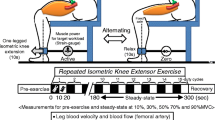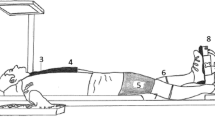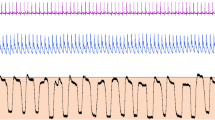Summary
The relative contraction force producing a reduction in exercise hyperaemia was studied by superimposing handgrip contraction at different intensities on plantar flexion of low intensity. Ten active women served as subjects. Blood flow to the forearm (\(\dot Q\) forearm) and calf (\(\dot Q\) calf) was measured with mercury-in-rubber strain gauges by venous occlusion plethysmography immediately after 60 s of rhythmic plantar flexion at 10% of maximum voluntary contraction (MVC), which was expressed as P10H0, or combined plantar flexion and handgrip contraction. In the combined exercise, handgrip exercise at 30%, 50% or 70% MVC was added to plantar flexion during the last 30 s of exercise (P10H30, P10H50 and P10H70, respectively). The \(\dot Q\) forearm increases after P10H30, P10H50 and P10 were significantly larger (P<0.01) than that after P10H0, and the difference between P10H30and P10H70 was also significant (P<0.01) Immediate post-exercise \(\dot Q\) calf after P10H0 increased by 7.4 (SEM 0.9) ml·100 ml−1·min−1. When handgrip contraction at 70% MVC was added, the \(\dot Q\) calf increase after exercise [4.5 (SEM 0.7) ml·100 ml−1·min−1] was significantly lower than after plantar flexion alone (P<0.05). However, no significant change was found in \(\dot Q\) calf when the forces of added handgrip contraction were 30% and 50% MVC, although the mean value of \(\dot Q\) calf increase was lower after P10H50 combined exercise. Calf vascular resistance calculated as \(\overline {BP}\)/\(\dot Q\) calf (\(\overline {BP}\) mean blood pressure) tended to increase after P10H70 to a nonsignificant extent. Heart rate and oxygen uptake in these exercises increased when handgrip contraction at 30%, 50%, or 70% MVC was added to plantar flexion at 10% MVC. However, the increases were considerably lower than the maximal ones. Thus, a reduction of \(\dot Q\) calf occurred even when the cardiac demand from the muscle was below its maximum. In conclusion, post-exercise hyperaemia in the active limb working at low intensity was inhibited by superimposition of exercise of another limb at a high contraction force. The critical force producing attenuation of exercise hyperaemia after combined exercise of short duration was found to be higher than 50% MVC in the case of handgrip contraction plus plantar flexion.
Similar content being viewed by others
References
Barcroft H, Dornhorst AC (1959) The blood flow through the human calf during rhythmic exercise. J Physiol 109:402–411
Barcroft H, Millen JLE (1939) The blood flow through muscle during sustained contraction. J Physiol 97:17–31
Barnes WS (1980) The relationship between maximum isometric strength and intramuscular circulatory occlusion. Ergonomics 23:351–357
Bonde-Petersen F, Mork A, Nielsen E (1975) Local muscle blood flow and sustained contractions of human arm and back muscles. Eur J Appl Physiol 34:43–50
Gaffney FA, Sjogaard G, Saltin B (1990) Cardiovascular and metabolic responses to static contraction in man. Acta Physiol Scand 138:249–258
Grucza R, Kahn J-F, Cybulski G, Niewiadomski W, Stupnicka E, Nazar K (1989) Cardiovascular and sympatho-adrenal response to static handgrip performed with one and two hands. Eur J Appl Physiol 59:184–188
Humphreys PW, Lind AR (1963) The blood flow through active and inactive muscle of the forearm during sustained hand-grip contraction. J Physiol 166:120–135
Kagaya A (1989) The rate of peripheral circulatory adjustment at the onset of exercise. Jpn J Phys Fitness Sports Med 38:167–174
Kagaya A (1992) Reduced exercise hyperaemia in calf muscles working at high contraction frequencies. Eur J Appl Physiol 64:298–303
Kagaya A, Minakuchi Y, Takahira W, Katayama S (1991) Respiro-circulatory responses to forearm and calf exercise performed simltaneously at an equal fraction of MVC (in Japanese with English abstract). Jpn J Phys Fitness Sports Med 40:447–454
Kjellmer I (1965) On the competition between metabolic vasodilation and neurogenic vasoconstriction in skeletal muscle. Acta Physiol Scand 63:450–459
Klausen K, Secher NH, Clausen JP, Hartling O, Trap-Jensen J (1982) Central and regional circulatory adaptation to one-legged training. J Appl Physiol Respir Environ Exerc 52:976–983
McCoy DE, Wiley RL, Clayton RP, Dunn CL (1991) Cardiopulmonary responses to combined rhythmic and isometric exercise in humans. Eur J Appl Physiol 62:305–309
Mitchell JH, Payne FC, Saltin B, Schibye B (1980) The role of muscle mass in the cardiovascular response to static contractions. J Physiol 309:45–54
Richter EA, Kiens B, Hargreaves M, Kjer M (1992) Effects of arm-cranking on leg blood flow and noradrenaline spillover during leg exercise in man. Acta Physiol Scand 144:9–14
Royce J (1958) Isometric fatigue curves in human muscle with normal and occluded circulation. Res Q 29:204–212
Rowell LB, Saltin B, Kiens B, Christensen J (1986) Is peak quadriceps blood flow in humans even higher during exercise with hypoxemia? Am J Physiol 251 (Heart Circ Physiol 20):H1038-H1044
Rowell LB, Savage MV, Chambers J, Blackmon J (1991) Cardiovascular responses to graded reductions in leg perfusion in exercising humans. Am J Physiol 261 (Heart Circ Physiol 30):H1545-H1553
Sadamoto T, Bonde-Petersen F, Suzuki Y (1983) Skeletal muscle tension, flow, pressure, and EMG during sustained isometric contractions in humans. Eur J Appl Physiol 51:395–408
Saito M, Mano T, Abe H, Iwase S (1986) Responses in muscle sympathetic nerve activity to sustained hand-grips of different tensions in humans. Eur J Appl Physiol 55:493–498
Saito M, Mano T, Iwase S (1990) Changes in muscle sympathetic nerve activity and calf blood flow during static handgrip exercise. Eur J Physiol 60:277–281
Saito M, Kagaya A, Ogita F, Shinohara M (1992) Changes in muscle sympathetic nerve activity and calf blood flow during combined leg and forearm exercises. Acta Physiol Scand 146:449–456
Saltin B (1985) Hemodynamic adaptation to exercise. Am J Cardiol 55:42D-47D
Savard G, Richter EA, Strange S, Kiens B, Christensen JN, Saltin B (1989) Norepinephrine spillover from skeletal muscle during exercise in humans: role of muscle mass. Am J Physiol 257 (Heart Circ Physiol 26):H1812-H1818
Secher NH, Clausen JP, Klausen K, Noer I, Trap-Jensen J (1977) Central and regional circulatory effects of adding arm exercise to leg exercise. Acta Physiol Scand 100:288–297
Sheriff DD, Wyss CR, Rowell LB, Scher AM (1987) Does inadequate oxyen delivery trigger pressor responses to muscle hypoperfusion during exercise. Am J Physiol 253 (Heart Circ Physiol 22):H1199-H1207
Sinoway L, Prophet S, Gorman I, Mosher T, Shenberger J, Dolecki M, Briggs R, Zelis R (1989) Muscle acidosis during static exercise is associated with calf vasoconstriction. J Appl Physiol 66:429–436
Start KB (1964) Load and local muscular isometric endurance with occluded blood supply. J Appl Physiol 19:1135–1138
Whitney RJ (1953) The measurement of volume changes in humans limbs. J Physiol 121:1–27
Author information
Authors and Affiliations
Rights and permissions
About this article
Cite this article
Kagaya, A. Relative contraction force producing a reduction in calf blood flow by superimposing forearm exercise on lower leg exercise. Europ. J. Appl. Physiol. 66, 309–314 (1993). https://doi.org/10.1007/BF00237774
Accepted:
Issue Date:
DOI: https://doi.org/10.1007/BF00237774




